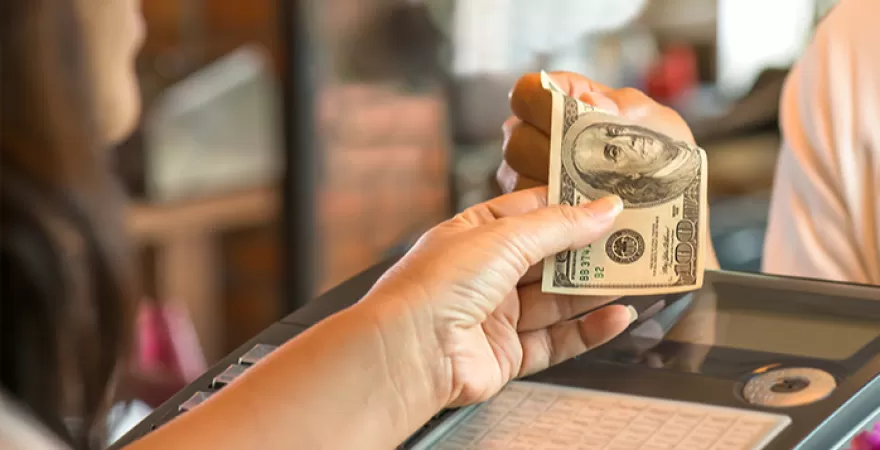[INTRO MUSIC PLAYS]
HOWARD:
Hello and welcome to Noteworthy by the U.S. Currency Education Program, or CEP. My name is Howard Williams and I'm the manager of the CEP. The CEP is responsible for ensuring the integrity of and trust in the U.S. dollar by providing information and training resources to the public. Check out our website at uscurrency.gov to find free information and training resources on U.S. currency.
Leading our discussion today will be Maria Hawkins, who is joining us now.
MARIA:
Hello, I'm Maria Hawkins, and I'm a member of the CEP team. I support domestic and international stakeholder outreach, and I'm happy to be here with you today. Today we're exploring the latest findings from the Federal Reserve's Financial Services most recent Diary of Consumer Payment Choice Survey to breakdown the insights discovered. We are joined by Claire Navarro Silver, an expert from the Federal Reserve Financial Services team. Welcome, Claire.
CLAIRE:
Thank you, Maria. I'm delighted to be here to share the Survey's findings with your listeners.
MARIA:
We're thrilled to have you. The Diary of Consumer Payment Choice Survey is conducted every October. Can you give us a brief overview of what the Survey is and what it aims to achieve?
CLAIRE:
Absolutely. The Survey is designed to analyze how American consumers pay for goods and services. This includes looking at various payment methods such as cash, check, and electronic payments - which include credit cards, debit cards, and mobile payments.
MARIA:
Despite the rise in online shopping and electronic payment methods, my understanding is that the Survey indicates that cash still plays a crucial role.
CLAIRE:
Yes, that's correct. While online shopping and electronic payments have grown significantly, cash is the third most frequently used payment instrument by Americans, behind debit and credit cards. It remains vital, especially for in-person transactions. The Survey shows that the total number of cash payments per month remained stable since 2021, at an average of seven cash payments per consumer. People are also holding on to more cash now than before the pandemic. This increase in holdings, despite the increase in electronic payments, suggests people find it beneficial to have cash readily available.
This past October, 79% of participants reported having cash in their pocket, their purse, or their wallet at least once a day during the Survey period, with the average amount held being $74.
MARIA:
What do the findings in the Survey tell us about cash users?
CLAIRE:
So cash payments are driven by in person shopping as well as the payment behavior of consumers in low-income households and individuals who are 55 and older. As a matter of fact, consumers living in households with income of less than $50,000 use cash for 28% of their payments as opposed to 13% of payments for those of higher incomes. However, and this is very interesting, nearly 3/4 of all cash payments were made by consumers who prefer credit cards.
In fact, for consumers who prefer credit cards as a payment method, cash was their second most used payment instrument. This tells us that while cash may no longer be the most used payment instrument, it is the preferred backup payment instrument for the majority of the population.
MARIA:
Can you tell us what these findings mean for the Federal Reserve?
CLAIRE:
So these findings are important for the Federal Reserve because they help us understand U.S. consumers’ payment behavior, their preferences, and how these factors change year over year. By understanding how much cash people are holding and where they use it, we can better fulfill our mission of meeting cash demand.
MARIA:
Before we wrap up this topic, is there anything else that you would like our listeners to know about what was learned from the Diary of Consumer Payment Choice Survey?
CLAIRE:
Just one more thing. Another notable finding was more than 90% of consumers intend to use cash as either a means of payment or a store of value in the future. Understanding how and when people use and hold cash helps us make more knowledgeable decisions to ensure that demand is met. This way, people can continue to use cash confidently, whether that is for everyday purchases, a gift during the holidays, or stored at home in a piggy bank for use in the future.
MARIA:
Now that we have discussed how consumers are using cash, let's share some information on how those consumers can authenticate their cash to ensure that it is real. Authenticating cash is straightforward, and it involves just a few key steps. Feel the bills’ unique cotton-linen texture. Tilt the note to see its security features like color shifting ink. And check for watermarks and security threads.
Using Feel-Tilt-Check, consumers can easily verify that their banknotes are genuine currency. The intricate design and advanced security features of U.S. currency play a significant role in maintaining its trust and reliability around the world. It is also very important to note that all U.S. bills remain legal tender, even older design notes. This means that they hold their face value no matter when they were printed and can be safely used for transactions. The Currency Education Program has several resources on our website, uscurrency.gov, such as an online training course and a mobile application.
As we learned today in our episode, cash plays a vital role in our economy, so we encourage our listeners who use cash to check out those resources.
Thank you, Claire, for joining us today. It's been a pleasure speaking with you.
CLAIRE:
Thank you, Maria, it's been great to be here.
MARIA:
And to our listeners, thank you for tuning in to Noteworthy. If you have any questions or would like to learn more about U.S. currency, visit uscurrency.gov. And please subscribe to our podcast so you don't miss out on future episodes and connect with us on social media.
Until next time.
[EXIT MUSIC PLAYS]


